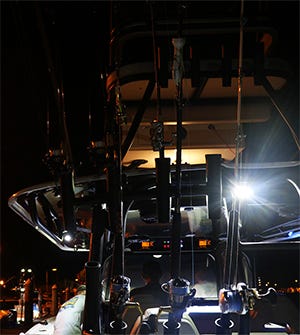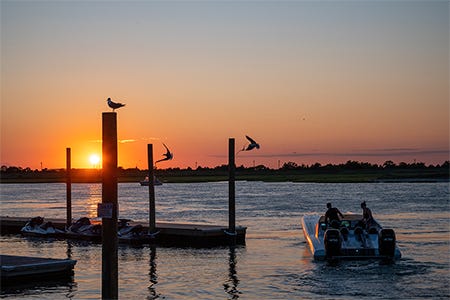

Summer can be a brutal time to be out on the water, particularly in southern regions, where the “dog days” of July and August offer little breeze and blazing heat. In spite of that, many waterways are increasingly congested, even on the hottest summer days. Between the heat and the crowds, many popular boating activities can be less appealing.
However, there is an often-overlooked alternative that some boaters have discovered. An entirely different world exists on the water when the sun goes down — cooler temperatures, glassy water, and the peaceful serenity that many boaters crave.
Contents
Night Boating
Boating at night offers some unique experiences that are not available during daylight hours. A relaxing evening cruise beyond the bright lights of civilization reveals the brilliance of the nighttime sky above and, in many saltwater areas, bioluminescence below. For sportsmen, night fishing can offer unique, and often epic, fishing opportunities around dock lights.
Even the most popular fishing spots can be completely deserted, offering the intrepid night angler a rare chance to fish in these areas alone. For all of its benefits, boating at night requires both increased preparation and caution. Everything looks different at night, and navigation can get tricky.
For all of its benefits, boating at night requires both increased preparation and caution.
A boating accident during the day is bad enough, but one at night can be much more serious. If you are new to nighttime boating, consider these tips to make your trip successful.
Double Check your Safety Equipment
Maintaining the right safety equipment is always important, but ensuring that it is both accessible and functioning is essential for nighttime boating. Having backup equipment, particularly for navigation lights, sound making devices (horns, whistles, etc.), and flares can make all the difference if something unexpected happens.
In most states, lifejackets do not have to be worn by adults over a certain age, but at night things can happen quickly. Take advantage of the cooler temperatures and encourage your passengers to wear their lifejackets
Lights Are Your Best Friend
On clear nights, it is remarkable how much natural light there can be out on the water. Allowing your eyes to adjust to the ambient light offered by the stars and the moon can give you better visibility than using a spotlight or even a flashlight. Be aware that any electric or electronic light source can limit your vision enormously, including your electronics.
Keep your electronics powered on so they are ready if you need them, but keep them covered to maintain your night vision. Spotlights and flashlights are necessary to have ready and available when night boating, but use them sparingly.
And Your Worst Enemy
Remember that your eyes will adjust to the strongest source of light, whether that is the dim, ambient light of the stars and the moon or the blazing light from a spotlight. Once your eyes adjust to brighter lights, you will lose visibility to anything more dimly lit, and it will take a much longer time to regain it than it took to lose it.
In fact, it can take 20 to 30 minutes for your eyes to fully adjust to nightime darkness and only a few seconds to lose that night vision.
While a spotlight or flashlight can be a powerful tool, the limited size of the beam means that you are blind to anything outside of it. When it comes to light, also be aware of your impact on other boaters. That brilliant spotlight or light bar on your boat may provide you with great visibility, but if it blinds the boater coming at you, it puts everyone at risk.
They need to see your navigation lights to judge your direction, but the blinding glare of a spotlight will make your navigation lights impossible to see. Just like you turn off your high-beams for oncoming traffic at night on the road, have the same consideration for other boaters on the water.
Know the Rules of Navigation
Many boaters have only the most basic understanding of proper navigation on the water, but those rules become absolutely essential at night. Before you embark on an after-hours excursion, take time to fully understand the laws of nighttime navigation. There are clear rules dictating which vessel has the right of way (the “stand on” vessel) and which vessel is responsible for avoiding collision (the “give way” vessel). In most cases, when looking at another boat’s bow lights, “green means go” and “red means stop,” but these basic rules can get more complicated.
Take the time to learn the basic rules of navigation and how to interpret the navigation lights on the other vessels you may see on the water.
It is also extremely important that you make your intentions clear on the water when you are near another boat. If the other captain understands the rules of navigation, they will be watching your navigation lights like you will be watching theirs.
However, it’s also important to realize that the other captain may be unclear on nighttime navigation rules. Demonstrating clear intent in your navigation can be just as important as following the rules. Making your path clear early on to the other boater eliminates confusion and can avoid a potential collision even when normal navigational rules aren’t followed.
Everyone Should Be Alert
At night, your sense of sight is limited and even the most experienced captain can become disoriented. Recognize this risk and engage your passengers to help with the task of keeping everyone safe. Most people, and kids in particular, like to feel involved.
A few minutes spent briefing your passengers on the role you need them to play and what to look for and listen for can make the trip fun, safe and enjoyable for everyone. Staying alert means relying on your hearing as well as your sight. In spite of clear night navigation laws, if you boat after dark often enough, you will eventually run across an unlit vessel. In many cases, the only warning you will get is the sound of their engine.
As a result, it is a good idea to keep your stereo off while underway at night and ensure your passengers are tuned in for the sound of other boat engines. Additionally, nighttime boating is not a good time to enjoy adult beverages. Low light conditions will confuse your senses enough, and alcohol will make it worse. Keeping your senses — and those of your passengers — sharp and reaction times quick is essential for night time boating.
Go Where You Know
One of the joys of boating at night is that it makes familiar places seem unfamiliar, adding an air of excitement and wonder to a trip you may have taken by day a hundred times. While it is best to avoid going into unfamiliar areas at night, if you must, try to scout the area by day prior.
Look for landmarks that will be visible at night and take your time. If the opportunity presents itself, follow other boaters at a safe distance, but recognize that they may lead you onto a sandbar or into a piling if they aren’t familiar with the area. A safe distance will give you time to react if their boat stops or changes course unexpectedly.
Regardless of whether you are in a familiar area or an unfamiliar one, it’s best to limit your speed to either a fast idle or a slow plane. Obstructions such as crab trap buoys, flotsam or even boaters in smaller, unlit craft will be much more difficult to spot at night. Keeping your speed as low as reasonably possible will give you the most time to react and minimize the impact of a potential collision.
Dress for the Occasion
Even in southern regions, the temperatures at night can feel downright chilly. Nighttime temperatures are often 15 to 25 degrees cooler than daytime temperatures. Combined with increased moisture in the air.
The summer temperatures at night may require springtime clothing.
Encourage your passengers to dress in layers and to bring jackets, extra towels and blankets. Although they may think you are crazy boarding the boat in the sultry evening, they will quickly discover how chilly a summer night can be, particularly when underway.
Magic of Nighttime Boating
Over the past few years, more people have discovered the joys of boating. As the waterways grow more crowded, taking advantage of a moonlight cruise or an after-dark fishing trip can help you rediscover the peace and solitude that your local waterway can offer.
Verifying that you have proper, operational safety equipment, learning the “rules of the road,” and taking a cautious approach will ensure that you and your passengers get to experience the magic of nighttime boating.



